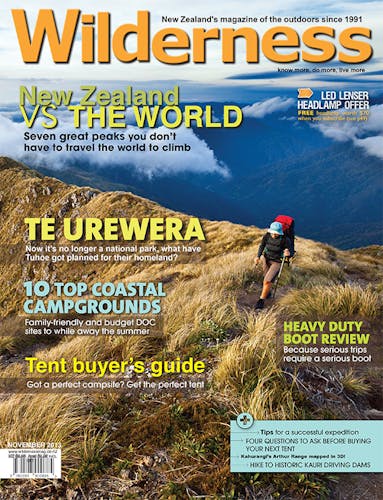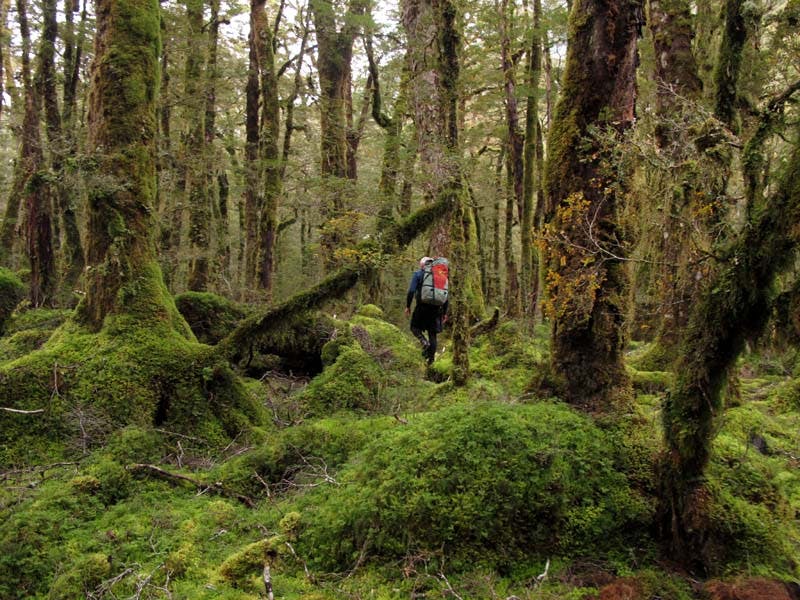On a trip to Fiordland, Mick Abbott realises that to know our wildest places you have to do more than simply walk in them
Monday. The phone rings and Kennedy asks: “Do you think you could come down to Fiordland tomorrow?” Tomorrow!
He shifts his tone to one he thinks is more reasonable. “What about the day after, then?”
Twenty logical reasons to say no flow through my head. Kennedy adds the magazine he’s doing a story for will pay for the flights. These logical reasons have now halved.
I think some more. Kennedy Warne, founding editor of NZ Geographic, was the first person to publish a story of mine – a process he guided me through in such a kind way I’m still happy with the resulting feature article 20 years on. Carli, my partner, says do it. Jacky, my boss, agrees. Logical reasons drop to zero.
Wednesday, midday. Kennedy stops his 4WD near the end of the Borland Road, just where the Emerald Stream emerges from the expanse of southern Fiordland.
“Fancy a coffee?” he asks. He pops the bonnet of his antiquated Hilux, hops out and connects the coffee grinder to his car battery. Auckland coffee culture meets Fiordland. He grins. “Can’t have stale grinds can we?”
So for 20 minutes we snack on ciabatta bread, brie, cherry tomatoes, smoked chicken and fresh coffee. Then with light overnight packs we leave the road and immediately tumble down the beech forest and into the boggy flats that stretch across the Grebe Valley.
I smile and consider what would be better: this, a perfectly sunny Fiordland day, or my office and emails?
Kennedy had left it to me to decide where we’d go. My choice was Emerald Stream – a trackless valley I’d once wandered up on a whim, only to realise, with its easy contour and hanging basins, it’s one of the best weekend tramps around.
It takes a while to settle into a rhythm and to read the best paths to take and make, as the valley features nudge us forward. Generally close to the river is best, except when it isn’t. The skill is in continuously adjusting the route according to the change in landforms, proximity to the valley walls and the various trails the deer have left. Slowly it begins to flow. And while we need to cross the river often, with some fords over waist deep, the river has no sense of nastiness in it.
Instead, its deeply red lichens, endless stretches of moss-covered boulders, and sparkling green pools of water reveal how the valley got its name.
Interspersed with our wonder are snippets of a discussion about changes taking place in our public conservation lands. Kennedy’s frustrated that it seems no-one understands that the exact spot where the Denniston mine is located is as unique as you can get – not just here in New Zealand, but across the planet. And I’m wondering if those proposing the monorail have ever driven the Borland Road to see the kind of scarring the required road will cause.
It’s getting late, and we haven’t gone as fast as we’d imagined. But then, what’s fast and slow here? In Fiordland, progress takes place in changing tempos as boulders, bluffs, cataracts and windfalls shape the speed of movement.
The sky shows some pinkiness and while neither of us thought to bring watches, we know it’s time to camp. Thankfully the spot we’ve got to is flat, so it’s pitch the tent, get a fire going, and smile. In the darkness, the sandflies disappear and Fiordland envelops us.
Thursday morning we’re blanketed in a thick mist. Outside the tent, the sandflies are queuing up. Rather than head over the saddle, and with it the pressure of getting out on time, we choose to return the way we came.
It’s like we’re in another valley. The landscape reads differently and for the three hours it takes, we’re retracing yesterday’s route for all of fifteen minutes.
Perhaps it’s because we’re more comfortable in this place. We wander away from the river more, tramping closer to the steep glacial walls as both we, and the river, meander from side to side.
Part way down we return to the pressing issues in our conservation lands, but more so to the magical qualities these special places have, and how the way we look after these places creates a collective sense of New Zealand identity.
Kennedy’s article is expected to span Aoraki/Mt Cook in the north, Mt Aspiring National Park and Fiordland. How do you convey the qualities of these places in just a few thousand words and a dozen photos? For Kennedy, it’s important to try.
It’s worth recalling it was Craig Potton’s photos, revealing the ecological marvel of our forests, that did as much as any petition to persuade people to stop clear-felling native trees.
It seems incongruous to be walking in the heart of Fiordland while also thinking of all the developments being planned for our public conservation lands. Prospecting seems to be back on the cards, as does a ‘tourist’ road from Haast to the Hollyford, which ominously brushes the mineral-rich Red Hills that mining interests have long had a fascination with. Further north there’s the impact major irrigation proposals have on water quality to consider.
My mind returns to the forest. Walking without a formed track is so tactile – holding aside branches, being squeezed between trees, and dropping from the bank directly into a deep stretch of water as the smoothest ford is sought. My mind clears and I again feel reconnected with the bush.
Over lunch I tell this to Kennedy, but he seems more restless. As we pack up to head to the road, he stops and stares at me. “You know what they say don’t you?” he says. “To know and not to act is not to know.”
I’m silent as the river babbles beside me and a piwakawaka fantail flits about. It takes a while, but slowly it sinks in. Knowing our wildest places demands more of us than just walking.








